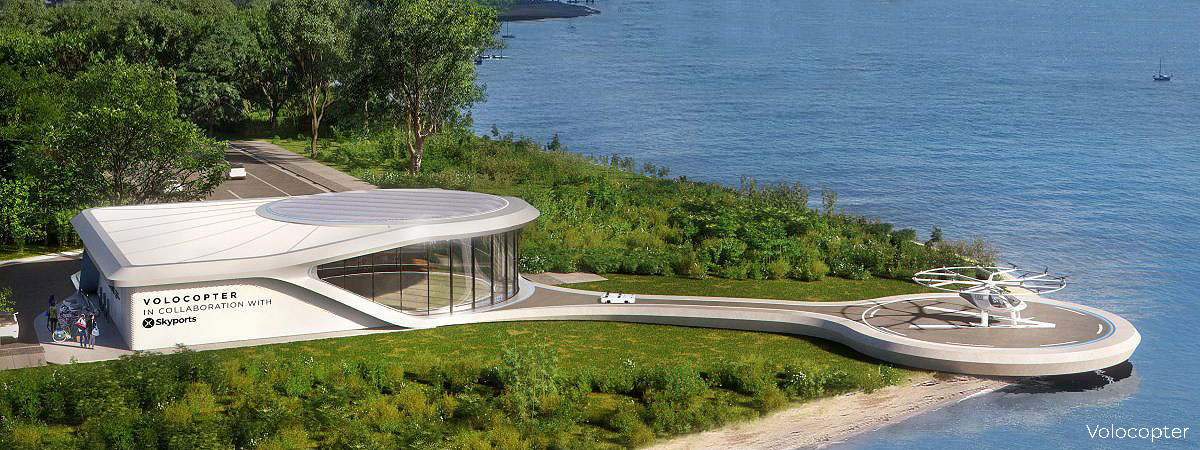From “Back to the future” to “The Fifth Element”, urban air mobility has been a recurring feature in popular culture that depicts the future. Now, technology makes it possible for us to edge a little closer on this front. And not only because we enjoy the technical challenge of turning fiction into reality, but also because private, light air travel can play a critical role in the smart, sustainable transformation of our transportation systems.
Vertiports represent an opportunity to develop interconnected services that integrate available energy and transport in urban areas in a sustainable and more rational way.
There is a real need. However, taking urban mobility to the air will require more than just the technology to make the vehicles fly. It will also involve rethinking our current transportation networks, together with the integration of even deeper changes in our urban environments in general.
For starters, these air vehicles will need to take off and land in specially prepared spaces for reasons related to security, logistics and availability. In the last two years, Airbus in collaboration with other organisations has invested in researching and planning the future or urban air mobility (UAM) as a growth opportunity for cities around the world.
Urban air mobility aims to improve our daily lives by reducing travel time and costs for moving people and transporting goods in and out of cities. Advancing the cause of sustainability in urban areas will be an effect that is collateral, but important, nonetheless.
Over the next ten years, the UAM market is expected to experience an annual growth rate of 11.33% with a business forecast of over $15 billion by the end of that period.
But to reach this point, UAM need a place to land.
What is a vertiport?
Vertiports are the platforms used by aerial vehicles, especially electric, for vertical take-off and landing. These infrastructures are designed not only as stations, but also as part of broader, multipurpose centres of renewable energy, data and public services where mobility and intermodality concepts are almost always part of the equation.
A vertiport is composed of an operational platform for aircraft manoeuvres and a connected building for the associated technical equipment (such as cargo infrastructure or passenger assistance). There are several types of vertiports that range from old heliports, which have been adapted with devices for electric charging, to specific, purpose-built vertiports.
Depending on the demand of passengers served, vertiport configurations may vary. Currently, the three most widespread configurations are the following: single vehicle with a single reception area on the side; single vehicle with three reception areas in the centre (providing greater capacity); two vehicles and four reception areas on the right (again, for greater capacity).
Space requirements and, above all, the general concept of moving towards more efficient and sustainable mobility, mean that a good number of vertiports are designed to complement existing transportation hubs or nodes. In these cases, vertiports can be integrated without adding significant tension to the existing infrastructure. They can be integrated into train or bus stations or with airports to complement or complete the transportation chain, or added to schools/universities, medical facilities, companies and more – without the need to build additional infrastructures on land (as in the case of railway tracks, for example).
However, entirely new centres are also being designed in areas that are difficult for other, more traditional transportation infrastructures to reach for entirely opposing reasons: urban saturation or isolation.
What are the inherent benefits of developing vertiports?
The potential benefits of vertiports vary according to the type of country/city the situation of its transportation networks:
- In developing countries or cities with less established public transportation networks, and in which new urban infrastructures are being built, there is an opportunity to build vertiports that connect remote neighbourhoods and provide transportation links to areas underserved by rails and roads.
High-quality, remote urban areas with limited mass transit needs could also be connected via air without the need for expensive mass transit infrastructure, such as rail corridors or improved roads, and to avoid any congested or indirect road transportation alternatives.
In this situation, it could be easier to develop vertiports than in developed countries because there would be fewer constraints imposed by existing buildings and fewer competing transportation options.
- In more developed countries, integrating vertiports in urban environments is considered to be an additional option to increase mass transport centres’ catchment areas, as well as offering a first-rate alternative for companies or users who need to travel quickly from one area of a city to another or to connect with airports (especially in cities without rapid transport connections between city and airport).
With the support of the right technologies and data analytics, these countries can offer services that respond to demand and improve customer experience.
Vertiports represent an opportunity to develop interconnected services that integrate an urban area’s available energy and transport in a sustainable and more rational way. Therefore, they must be designed so that they can be used within the existing building structures. In the future, they could be directly integrated into new essential service facilities as they are built (schools/universities, medical centres, companies, etc.)
In the United States, for example, these landing sites and structures will be linked to property within a county, city or state, each of which may have completely different laws regarding infrastructure integration and compliance.
There are dozens of VTOLs (Vertical Take-Off and Landing aircraft) in various stages of development, and their manufacturers hope to land a chunk of the budding, but potentially lucrative market for flying taxis. Hyundai expects the air mobility market to be worth nearly $1.5 trillion over the next 20 years.
Vertiport construction challenges
Before building a vertiport, operators must ensure they meet all requirements for safe, robust and scalable operation. Furthermore, in order to implement UAM, questions related to certification (involving crews) as well as surveillance, air control and security must be resolved.
In order for urban air mobility (UAM) to take off, VTOLs must prove their safety and reliability, air traffic management must adapt to accommodate them, the public will have to accept this new mode of transportation, and it needs to be affordable. And there is another important obstacle we already mentioned: adequate infrastructure is needed to land, recharge and take off with passengers.
Vertiports: where are they and where will they be?
The world’s first air taxi vertiport prototype was unveiled in October 2020 on the Float in Singapore’s Marina Bay during the World Congress of Intelligent Transport Systems. The “VoloPort” is the outcome of a partnership between the air taxi manufacturer Volocopter and Skyports, the UK-based vertiport developer, owner and operator.
Skyports is working with a dozen other megacities around the world. It aims to be the first to roll out commercial air taxis, especially in Los Angeles, where Uber has publicly stated it intends to operate air taxis by 2023.
The strategy for rolling out vertiports, according to the CEO of Skyports, includes connecting urban business centres and the main airports, highlighting that “vertiports will be a really important part of the general network, since clearly there is a lot of traffic congestion between airports and city centres. ”

#uam


